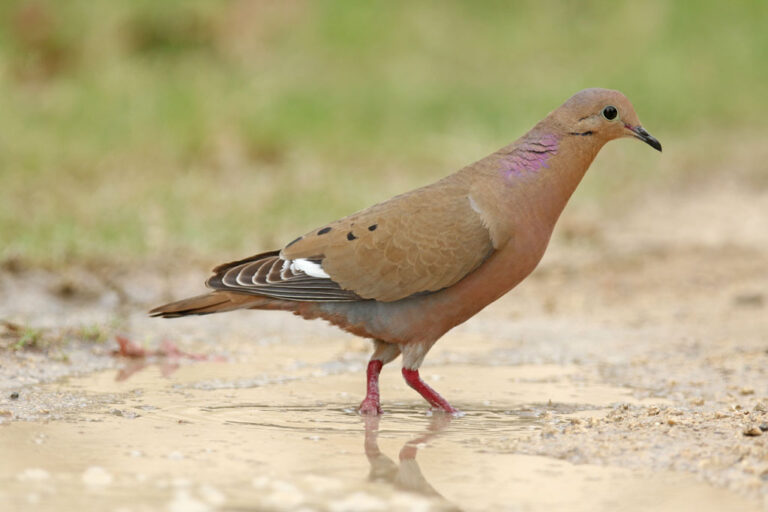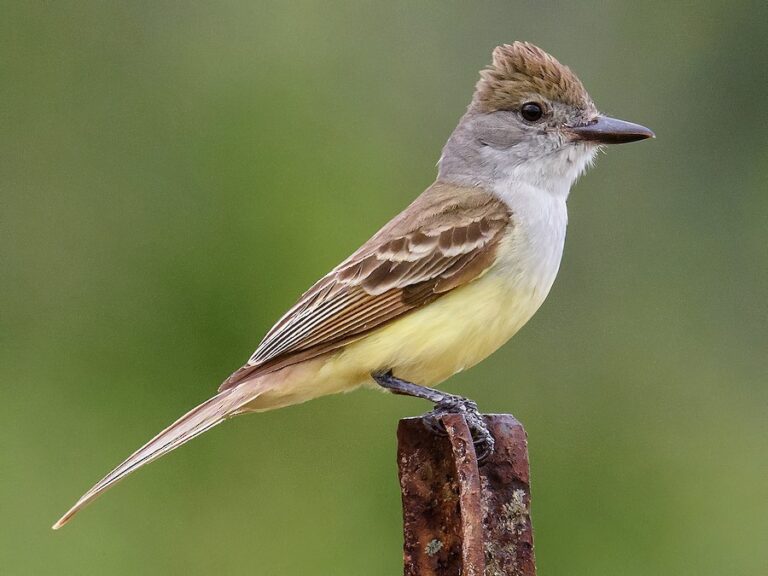Top 7 Black and White Ducks Found In North America
Ever thought about those gorgeous black and white ducks in North America? These ducks are famous for their striking black-and-white patterns. So, what makes their color combo so eye-catching? Let’s explore the beauty of these birds and find out why they stand out.
Popular Black And White Ducks
North America has many captivating waterfowl. This includes various black and white ducks that draw in birdwatchers and nature lovers. We will look at some of the most popular ones in this area.
Bufflehead Ducks
The Bufflehead (Bucephala albeola) is a small, buoyant duck. You can see them bobbing in bays, estuaries, and lakes in winter. They are known for their black and white feathers. Male Buffleheads are mainly white with black feathers on their backs, necks, and heads. This makes them vivid against the water.
Wood Ducks
The Wood Duck (Aix sponsa) is often seen as North America’s most beautiful duck. Its plumage is truly unique. Both males and females have black and white patterns, but the males’ multicolored feathers are stunning. They shine in iridescent greens, blues, purples, and browns. White marks on the face and throat add to their beauty.
Greater Scaup Duck
Another stunning black and white duck in North America is the Greater Scaup (Aythya marila). Males have heads that glow dark green with iridescent bluebills. They also have gray barred backs. Their white sides stand out against the dark, making them clearly visible among other ducks.
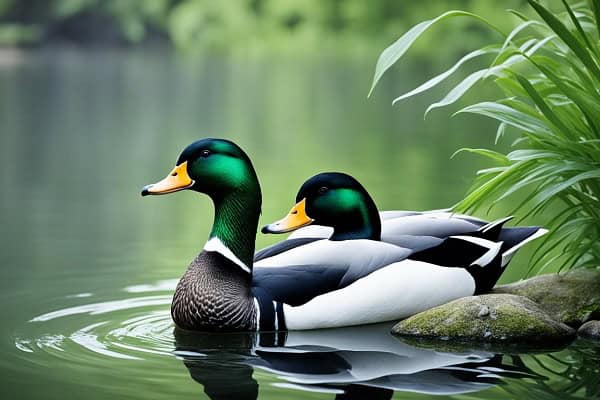
Rare And Unique Black And White Ducks
In North America, many black and white ducks can be seen. But one species, the Madagascar Pochard, is truly rare. It is considered the rarest duck in the world, with less than 30 left. It lives only in Madagascar. This duck stands out with its black head and neck, white body, and red eyes.
The Madagascar Pochard is both rare and beautiful. It attracts birdwatchers and nature lovers around the globe. Its very low numbers highlight the urgent need to protect these amazing ducks and their homes.
“The Madagascar Pochard is a true gem, a unique black and white duck that captivates all who are fortunate enough to witness its beauty. Its rarity only adds to the allure, making it a must-see for any avid birdwatcher.”
The Madagascar Pochard represents the stunning wildlife diversity of our planet. It is critical to protect it. Efforts to save this unique duck highlight the importance of conservation. We must work to protect our natural world.
Black and White Ducks
The avian world is truly amazing, especially the waterfowl. Black and white ducks greatly catch our eye with their unique look. These beautiful birds live in North America, enhancing the scenery of its waters.
Hooded Mergansers and Wood Ducks are just a few examples. They make birdwatchers and nature lovers very happy.
One famous black and white duck is the Bufflehead. It’s small, about 13-16 inches long. People often see it in lakes and ponds. Males have a black back and a white head patch. Females and non-breeding males are more plain in appearance.
The Common Eider is another eye-catching duck. It’s bigger, about 24-28 inches long, and it loves the coast. These ducks look elegant on the water and eat mollusks and crustaceans.
The Long-Tailed Duck is medium-sized and thrives in the cold. It’s 18-23 inches long. The unique thing about them is their long tail feathers.
| Duck Species | Size (Length) | Habitat |
|---|---|---|
| Bufflehead | 13-16 inches | Freshwater lakes and ponds |
| Common Eider | 24-28 inches | Coastal, marine environments |
| Long-Tailed Duck | 18-23 inches | Arctic waters, bays, and estuaries |
| Common Goldeneye | Around 16-20 inches | Lakes, rivers, sheltered coastlines |
| Barrow’s Goldeneye | Marginally larger than Common Goldeneye | Freshwater lakes and coastal waters, predominantly in the northwest |
The Common Goldeneye and the Barrow’s Goldeneye are striking too. The Common Goldeneye appears in many parts of North America. Meanwhile, the Barrow’s Goldeneye is mostly found in the northwest.
These ducks are not just beautiful; they’re important for the environment. Taking care of them and their habitats ensures our natural world stays rich with beauty.
1. Bufflehead Duck
Meet the Bufflehead duck, a small but amazing waterfowl from North America. They’ve got beautiful black and white feathers. In winter, you can spot them on the water at places like bays and lakes.
Despite being just 16 inches long and one pound, these ducks are quite special. They have a smart way of finding food that makes them stand out.
One of the Bufflehead’s best traits is the big white patch on the male’s head. It really shines with green and purple. The females might look different with their gray feathers, but they are just as easy to see thanks to how they float.

Buffleheads pick places in Canada’s forests and wetlands to make their nests. Nearly all of them choose Western Canada for this. They lay eggs in lakes and ponds then watch over them.
About 30 days later, the baby ducks hatch, but only about half make it. They face dangers from other animals and the cold. This is how Buffleheads start their families.
When it gets cold, Buffleheads fly to warmer places for the winter. They eat a lot to prepare for their journey. You can see these ducks in the Midwest, the Appalachians, and even down in Mexico.
Birdwatchers find Buffleheads exciting to watch because they dive underwater for food. This is different from most ducks. It makes them quite interesting for anyone who loves nature.
Though small, Buffleheads are not popular for hunting because they don’t offer much meat. They are very clever and hard to hunt, making up a small part of the ducks hunted in Canada.
Learning about the Bufflehead duck shows us how amazing nature can be. They are not just pretty. They also have smart ways to find food. And they add so much to the variety of ducks in North America.
2. Ring-necked Duck
North America is home to many waterfowl, but the ring-necked duck stands out. These ducks are known for their black and white look. The ring around their necks is where they get their name from.
Male ring-necked ducks are around 17 inches long. Females are slightly smaller. They are smaller than some ducks but are similar in size to others.

These ducks make their homes in North America’s boreal forests and prairies. They can be seen from Alaska to Newfoundland and as far south as California and Arizona. They also breed in central Canada and just north of the Great Lakes. In the winter, they fly to warmer places, reaching as far as Central America.
Ring-necked ducks dive for their food, which includes snails, small sea creatures, and plants. They like feeding in small, calm waters rather than large lakes.
The male ring-necked duck is a beautiful bird with black, gray, and white feathers. A white line on its chest and a white ring near its bill’s tip make it stand out. Females look similar to other duck species but have a distinct eye-ring.
These ducks travel far during migration, with many going through the southern Mississippi Flyway. This flyway is a favorite spot for birdwatchers and nature lovers, showcasing the amazing waterfowl diversity of North America.
3. Hooded Merganser
If you love watching birds in North America, chances are you’ve seen the hooded merganser. This small, black and white duck has a very special crest on its head. It stands out among the many types of diving ducks in the area.
Hooded Mergansers Description
A sight to see, the hooded merganser is. The adult males have a black head with a large white patch on either side. This makes it look like they’re wearing a unique cloak or crown. It gives them a cool, oblong head shape when they puff it up. On the other hand, females and young ones have warm tawny-cinnamon tones on their heads with a white spot under their chin.
When they fly, you can see some white on their wings, especially near the body. This makes figuring out who they are a bit easier. They’re between the size of a red-breasted merganser and a bufflehead, or about the size of a crow. Courting is special for these ducks, too. The males fluff their crests and dance for the females to get their attention.

Hooded mergansers like freshwater lakes and rivers a lot more than salty water. They make their homes in natural cavities or woodpecker holes in trees – alive or dead. And they’re usually close to fresh water. But in winter, they prefer bigger lakes, marshes, and calm saltwater bays.
These ducks are smaller than Canada Geese yet bigger than Mallards. Males weigh 15-30 ounces and have a 24-inch wingspan. They can even live up to be 14 years old. Unfortunately, their numbers are dropping due to areas being cut down and water getting polluted.
Whether you’re by a quiet river or in a wildlife refuge, look for the amazing hooded merganser. It’s a beautiful bird in North America, notable for its black and white look.
4. Common Merganser
The common merganser is a remarkable diving duck found in North America. It has a long, thin, serrated bill perfect for catching fish. These ducks are strong swimmers and divers, hunting fish underwater.
The males stand out with a white body, black back, and green head. Females are more grey with a reddish-brown head. But, both have bills designed to help them catch and eat their fishy meals.
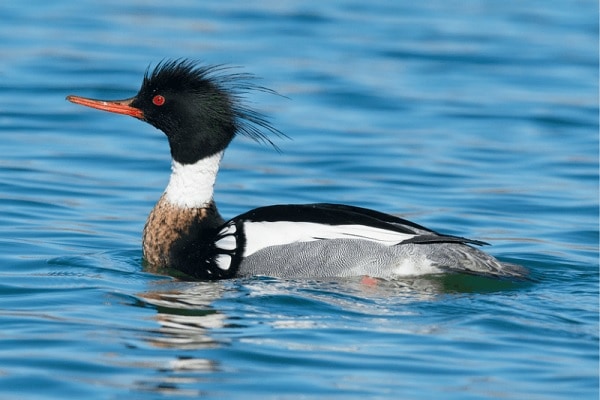
During the breeding season, they pair off and build their nests near water. These nests are made with plants and feathers. Females lay between 6 to 17 eggs and sit on them for about a month.
The common merganser is doing pretty well, listed as “Least Concern”. But, they do face dangers like losing their homes, pollution, and disruptions by people. They are amazing to watch with their diving and hunting skills in the wild.
| Characteristic | Description |
|---|---|
| Scientific Name | Mergus merganser |
| Length (Male) | Approximately 25-28 inches (63-71 cm) |
| Plumage Difference (Male vs Female) | Males have a white body, black back, and iridescent green head, while females have a gray body and reddish-brown head. |
| Clutch Size | 6 to 17 eggs |
| Incubation Period | Approximately 28 to 35 days |
| Conservation Status | Least Concern (IUCN) |
| Primary Diet | Fish, crustaceans, aquatic insects |
| Feeding Behavior | Skilled divers, catch prey underwater |
| Preferred Habitat | Freshwater habitats such as rivers, lakes, and ponds |
| Geographical Range | Found across North America, Europe, and parts of Asia |
The common merganser stands out with its unique way of finding food and its beautiful look. Their special bills and diving skills are just some of the things that help them survive in various freshwater areas across North America.
5. Common Goldeneye
Meet the stunning common goldeneye. This is a medium-sized diving duck that calls North America home. Known for its bold black and white look and those iconic circular white patches, the Bucephala clangula is a marvel of nature.
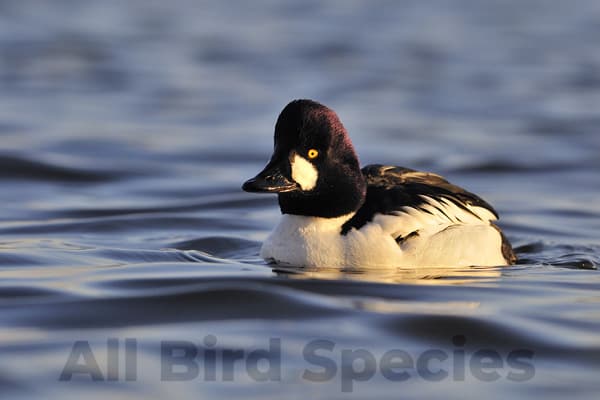
These birds mainly breed in Canada and Alaska’s forests. Some also choose to nest in parts of the northern United States. They pick lakes that are full of small water creatures and have clear water. These places are perfect for their diving and hunting ways.
When winter comes, common goldeneyes head south to the lower 48 states. Here, they enjoy shallow coastlines and bays. These ducks have a varied diet, including small water creatures, fish, and fish eggs. They also eat some plants. All this food helps them dive with great skill.
The common goldeneye is faithful to one partner. Pairing up happens between December and April. The female lays 4-9 eggs, which then take about a month to hatch. With about 2.5 million around the world, they are a common sight in North America. Thankfully, their numbers are holding steady.
If you love birdwatching or just the outdoors, the common goldeneye is a must-see. Look for these diving ducks in your local water areas. You’ll be amazed by their unique features and habits.
6. Lesser Scaup
The lesser scaup is a small diving duck seen across North America. They stand out with their black and white colors. In winter, thousands of them gather together, making quite a view.

Lesser Scaup Diving Behavior
These ducks are skilled divers. They hunt for food like bugs, snails, and plants underwater. Seeing them dive together is like watching a show.
Measuring around 41.7–43cm long and having a wingspan from 68-78cm, they are good at diving. They have black heads with a little purple and white bodies. This makes them easy to spot, even far away.
They breed in the Prairie Pothole Region and Canada’s boreal forest, reaching the tundra in the north. In winter, you can find them near freshwater areas, from the US-Canada border down to northern Colombia.
About 3.7 million lesser scaup ducks breed globally, so they’re not on high alert for conservation. But their numbers are slowly dropping. It shows why protecting their homes is vital.
Lesser scaup stand out with their diving skills and large groups. Whether you see a few or many, these ducks are memorable on any nature trip.
Read Our Previous Articles
| What is Hobbes Bird? |
| Hawks in Ohio |
| Falcon Symbolism: Meanings and Cultural Significance |
| Do Geese Have Teeth on Their Tongues? |
| Mourning Dove Facts |
7. Red-breasted Merganser
The red-breasted merganser is a striking black and white duck. They live across North America. This medium-sized diving duck stands out with its long, slender red bill. The males have a green head and a bright red breast. Females are different, with a gray body and a rusty head.

What’s amazing about these ducks is their ability to migrate long distances. They breed in Canada and Alaska’s northern regions. Then, they fly south to the United States and Canada’s coasts for winter. You can find them from the Great Lakes to Canada’s east coast. In winter, they gather along the Pacific and Atlantic coasts.
Red-breasted mergansers are known for their diving skills. They spend half their day diving and hunting under the water. They can go as deep as 30 feet and stay under for almost a minute. These dives help them catch fish and other water creatures. They’re also some of the fastest ducks in North America, flying at over 80 miles per hour.


